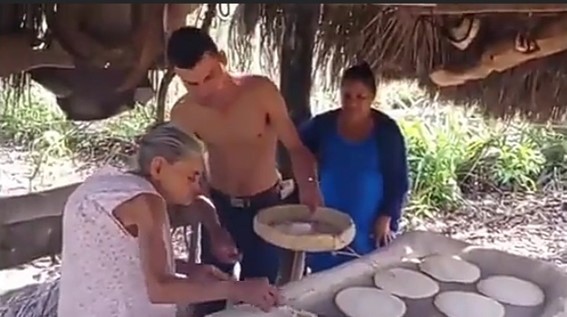Defending Cuba’s Tradition of Indigenous Bread
The Slow Food Amigos del Casabe de Cuba (Friends of Cassava Bread in Cuba) community is promoting sustainable eating habits via exchanges, posts and other activities on Facebook.

HAVANA TIMES – What secrets, differences or similarities are hidden in the bread-making process of pan de los indios, cassava bread, in cities such as Holguin, Baracoa, Bayamo or Havana? These special features and different historic points of this food were covered in the webinar “Cassava bread production in Cuba”, streamed on Facebook.
On March 29th and 30th, families from different Cuban provinces shared videos on the Amigos del Casabe page, showing their experiences of making this native food, made since Pre-Colombian times and still with a strong presence in eastern Cuba.
Yoel Fontaine, a cassava producer and one of its greatest advocates, pointed out that the webinar is a unique opportunity to learn about the homemade process of making this food. He also explained that the first virtual session was held to encourage an exchange between producers, consumers, promoters and the general public.
“We are doing something inclusive so that everyone feels represented and can participate, thereby giving life to cassava bread. It’s an ancestral food that has always had its space in our diet in its own right,” Fontaine added.
The Amigos del Casabe group plans to hold other virtual sessions about cassava bread. For example, it will bring professional chefs who defend culinary traditions together in June. In September, it will deal with history and anthropology, while the science of food will be discussed in December.
“The virtual meetings form part of the activities by the Friends of Cassava Bread Community, which was created within the Sustainable Food Movement in the Caribbean country,” Yudisley Cruz, one of the organizers, said.

Cruz believes that rescuing and promoting cassava bread is in keeping with the international movement “Slow Food”, which was founded in Rome in 1989 and encourages natural foods and defending ancestral wisdom, as the foundations of food security.
Before the pandemic began, over a year ago, the First Cassava Bread Festival was being prepared in Havana, but it was canceled due to the epidemiological situation. According to Fontaine, a meeting will be organized as soon as conditions allow for it, to pick up on this festival’s organization.
Family traditions
In this web seminar, the protagonists of Cuba’s cassava bread tradition were made known (perhaps like never before), and the Caribbean country shares this culture with other Caribbean countries, including Venezuela and Colombia.
From the Jururu-Bariay district in eastern Holguin, the short movie directed by the group of the same name and edited by the Kaweiro project, showed how the so-called “yuca brava” or “amarga” is washed and grated, and is then sifted in the sebucan (a kind of press), a handle or thick tube made of sugar cane or palm is then used to press the grated cassava, extracting its toxic juice so you can cook cassava bread.
Meanwhile, the video shows how the tortas are cooked in the buren, a griddle or small pan, and sandwiches are made with eggs and tomatoes.
In different stages of the process, Regino Rojas, Benedicto Paz, Felix Ballán, Ernestina Zaldívar, Adolfina Rojas, Antonio Rojas, Rubiseida Perez, Miguel Angel Abreu, Eduardo Batista, Aime Zaldívar, Ines María Rojas and Daniel Rodriguez, alternated, like they have their entire lives.
Cassava breadmakers from Yare, Holguin, weren’t left behind in a documentary by the community film project Almiqui.
The mini-industry here has been passed down from generation to generation. “These burenes were here making cassava bread, ever since I was born,” 66-year-old Bernardo Zúñiga said. Today he helps his son, Osmany, who runs their business.
While filling some tortas with guava and cheese in front of the cameras, Wildemar Biamonte, a baker, points out: “many people might not know them in the west of Cuba, but it’s here in the East its where the make them and eat them the most. The best filling is roasted pork.”
A producer from Las Tunas tells his neighbors they should make cassava bread, because it doesn’t have fat or salt, nor do you need to use electricity to make it, just wood, to eat it “toasted, with pork fat or made moist with salty water, toasted, with scrambled eggs.”
From History’s hand
One of the webinar’s objectives is to raise awareness about an ancestral tradition that forms part of the country’s culinary culture. This was presented by Domingo Cuza, a historian and director of the Tourist Information Bureau (INFOTUR) in Bayamo, Granma.
“Cassava bread is one of the oldest foods that the country and whole of the Caribbean enjoys,” Cuza highlighted, who reminded us of a phrase that is attributed to priest Bartolome de las Casas who, in a letter to the Spanish king, wrote: “don’t send us any more flour because it just gets worms, we already have a champion, a bread that is better, pan de los indios.”
He also stressed how this food became one of the first products to be exported from the archipelago for the conquest of the Americas to continue, and how it was the favorite of Independence-movement fighters in the jungle, as you only needed wood, a hot stone and grated cassava to make it, plus it could be stored for years in a cool and dry space.
According to the historian, in spite of having a tradition over 500 years old in Cuba and the Caribbean islands, cassava bread is more of a modern and contemporary food. It doesn’t contain gluten, so people with celiac disease can eat it, as can the overweight because it doesn’t have any fat. Likewise, it’s a favorite among vegans and vegetarians as it a product that comes from the earth.





